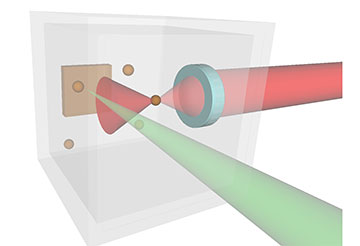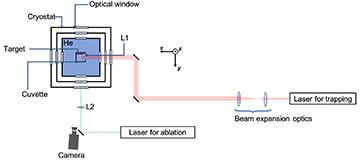
Japanese researchers have trapped nanoparticles inside superfluid helium by using a pulsed laser (green) to eject them from a target and a continuous-wave laser (red) to hold them at a tight focus. [Image: Minowa, Yosuke]
Scientists in Japan have shown for the first time how to trap nanoparticles in superfluid helium using optical tweezers (Optica, doi: 10.1364/OPTICA.447557). They say their technique could provide researchers with a new way of studying the boundary between the quantum and classical worlds.
Overcoming thermal fragility
Optical tweezers are highly focused beams of laser light used to hold and manipulate tiny objects, including atoms, drops of liquid and living cells. But, to date, operating them at the cryogenic temperatures—which could yield insights into exotic quantum phenomena—has proved difficult, given the thermal fragility of the necessary high-numerical-aperture lenses.
In the latest work, Masaaki Ashida of Osaka University, Japan, and colleagues have shown how to overcome this problem by incorporating a molded aspheric lens into the wall of a small glass container known as a cuvette that they immersed into a sample of liquid helium held at 1.4 K—some two orders of magnitude lower than had previously been possible for optical trapping.
To release nanoparticles into the helium, the researchers fired nanosecond laser pulses at a target on one of the walls inside the cuvette. That target consisted of either ready-made gold nanoparticles coated on a cover slip or a piece of sintered semiconductor zinc-oxide, from which nanoparticles were created in situ.
The optical tweezers themselves were formed using a second laser, which produced a linearly polarized continuous-wave beam oriented at right angles to the first and directed at the aspheric lens. This generated a tight focus inside the cuvette—the point at which the nanoparticles would be held.
Schematic of the experiment. [Image: Y. Minowa et al. Optica 9, 139 (2022)] [Enlarge image]
Determining the particle size
To establish whether optical trapping would be possible in superfluid helium, the researchers calculated the force that would be exerted along the tweezers’ axis. Integrating this quantity, they found that there should exist a potential-energy minimum—and hence the possibility of trapping—for particles around 10 nm across, but not much larger. As they point out, the optical dipole force that pulls particles towards the laser’s focus scales with the third power of the particle size whereas Rayleigh scattering—which tends to push particles away—scales with the sixth power.
The researchers then compared their calculations with the potential energy depth needed for stable optical trapping at different temperatures—the minimum threshold occurring at 10 kBT. On this basis, they worked out that no particles of any size would experience a potential well deep enough to withstand the thermal battering at room temperature. But at liquid helium’s distinctly frigid 1.4 K, trapping should occur for all gold particles with diameters between 10 nm and 77 nm as well as for zinc oxide particles measuring 10 nm to 120 nm across.
Carrying out their experiment, Ashida and co-workers found that they were indeed able to stably trap nanoparticles using the optical tweezers—managing to hold them in place for at least half an hour. They were able to image the trapped particles thanks to the copious amounts of light they scattered, and confirmed that, after blocking the laser beam then turning it back on, the trapped particles were nowhere to be seen.
The researchers note the importance of being able to determine the size of the trapped particles, given that this dictates the interaction with the surrounding quantum fluid. By measuring the power of light scattered from trapped zinc-oxide nanoparticles and using scattering theory to relate that power to the particles’ size, they concluded that the particles in question measured between 30 nm and 50 nm across—consistent, they say, with their potential-energy based calculations.
“A striking possibility”
Ashida and colleagues reckon that their technique will “open up a new pathway to study quantum hydrodynamics” by allowing accurate monitoring of trapped nanoparticles’ position and motion. But they point out that calibrating the photodiodes needed to capture the very high frequency motion (of around 100 kHz) will be complicated by not knowing the effective viscosity of the fluid. They say that overcoming this problem will require additional equipment such as a precise translation stage.
If they can get over the technical hurdles, they add, then “a striking possibility” presents itself—being able to control the quantum vortices that occur in superfluid helium. They note that vortex dynamics can already be observed by imaging the scattered light from nanoparticle tracers dispersed in the superfluid, but they point out that such experiments rely in part on vortices accidentally colliding with one another. They argue that their technique, in contrast, “could act as a new method to control quantum vortex motion, and dynamically perturb and excite quantum vortex states.”

